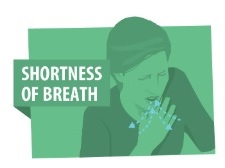
Cognitive behavioral therapy (CBT) is a psycho-social intervention that aims to reduce symptoms of various mental health conditions, primarily depression and anxiety disorders. Cognitive behavioral therapy is one of the most effective means of treatment for substance abuse and co-occurring mental health disorders. CBT focuses on challenging and changing cognitive distortions and their associated behaviors to improve emotional regulation and develop personal coping strategies that target solving current problems. Though it was originally designed to treat depression, its uses have been expanded to include many issues and the treatment of many mental health conditions, including anxiety, substance use disorders, marital problems, ADHD, and eating disorders. CBT includes a number of cognitive or behavioral psychotherapies that treat defined psychopathologies using evidence-based techniques and strategies.

Asthma is a long-term inflammatory disease of the airways of the lungs. It is characterized by variable and recurring symptoms, reversible airflow obstruction, and easily triggered bronchospasms. Symptoms include episodes of wheezing, coughing, chest tightness, and shortness of breath. These may occur a few times a day or a few times per week. Depending on the person, asthma symptoms may become worse at night or with exercise.

Shortness of breath (SOB), also medically known as dyspnea or dyspnoea, is an uncomfortable feeling of not being able to breathe well enough. The American Thoracic Society defines it as "a subjective experience of breathing discomfort that consists of qualitatively distinct sensations that vary in intensity", and recommends evaluating dyspnea by assessing the intensity of its distinct sensations, the degree of distress and discomfort involved, and its burden or impact on the patient's activities of daily living. Distinct sensations include effort/work to breathe, chest tightness or pain, and "air hunger". The tripod position is often assumed to be a sign.

The Buteyko method or Buteyko Breathing Technique is a form of complementary or alternative physical therapy that proposes the use of breathing exercises primarily as a treatment for asthma and other respiratory conditions.
A relaxation technique is any method, process, procedure, or activity that helps a person to relax; attain a state of increased calmness; or otherwise reduce levels of pain, anxiety, stress or anger. Relaxation techniques are often employed as one element of a wider stress management program and can decrease muscle tension, lower blood pressure, and slow heart and breath rates, among other health benefits.
Systematic desensitization, or graduated exposure therapy, is a behavior therapy developed by the psychiatrist Joseph Wolpe. It is used when a phobia or anxiety disorder is maintained by classical conditioning. It shares the same elements of both cognitive-behavioral therapy and applied behavior analysis. When used in applied behavior analysis, it is based on radical behaviorism as it incorporates counterconditioning principles. These include meditation and breathing. From the cognitive psychology perspective, cognitions and feelings precede behavior, so it initially uses cognitive restructuring.

Bronchoconstriction is the constriction of the airways in the lungs due to the tightening of surrounding smooth muscle, with consequent coughing, wheezing, and shortness of breath.

Breathwork is a term for various breathing practices in which the conscious control of breathing is said to influence a person's mental, emotional, or physical state, with a therapeutic effect.

Flail chest is a life-threatening medical condition that occurs when a segment of the rib cage breaks due to trauma and becomes detached from the rest of the chest wall. Two of the symptoms of flail chest are chest pain and shortness of breath.

Levosalbutamol, also known as levalbuterol, is a short-acting β2 adrenergic receptor agonist used in the treatment of asthma and chronic obstructive pulmonary disease (COPD). Evidence is inconclusive regarding the efficacy of levosalbutamol versus salbutamol or salbutamol-levosalbutamol combinations, though levosalbutamol is believed to have a better safety profile due to its more selective binding to β2 receptors versus β1.
Progressive muscle relaxation (PMR) is a method of deep muscle relaxation that does not involve any medications, meaning it is a non-pharmacological intervention. The idea behind progressive muscle relaxation is that there is a relationship between a person's mind and body. The body responds to its environment by creating certain mind or body states such as anxiety, stress, and fear. When the body is in these states, the muscles tense up. Progressive muscle relaxation aims to reverse these body states back to more neutral, relaxed states.
In the management of Parkinson's disease, due to the chronic nature of Parkinson's disease (PD), a broad-based program is needed that includes patient and family education, support-group services, general wellness maintenance, exercise, and nutrition. At present, no cure for the disease is known, but medications or surgery can provide relief from the symptoms.
Immersion therapy is a psychological technique which allows a patient to overcome fears (phobias), but can be used for anxiety and panic disorders.
Vocal cord dysfunction (VCD) is a pathology affecting the vocal folds characterized by full or partial vocal fold closure causing difficulty and distress during respiration, especially during inhalation.
Chronic headache, or chronic daily headache (CDH), is classified as experiencing fifteen or more days with a headache per month. It is estimated that chronic headaches affect "4% to 5% of the general population". Chronic headaches consist of different sub-groups, primarily categorized as chronic tension-type headaches and chronic migraine headaches. The treatments for chronic headache are vast and varied. Medicinal and non-medicinal methods exist to help patients cope with chronic headache, because chronic headaches cannot be cured. Whether pharmacological or not, treatment plans are often created on an individual basis. Multiple sources recommend multimodal treatment, which is a combination of medicinal and non-medicinal remedies. Some treatments are controversial and are still being tested for effectiveness. Suggested treatments for chronic headaches include medication, physical therapy, acupuncture, relaxation training, and biofeedback. In addition, dietary alteration and behavioral therapy or psychological therapy are other possible treatments for chronic headaches.

In psychology, relaxation is the emotional state of low tension, in which there is an absence of arousal, particularly from negative sources such as anger, anxiety, or fear.
PTSD or post-traumatic stress disorder, is a psychiatric disorder characterised by intrusive thoughts and memories, dreams or flashbacks of the event; avoidance of people, places and activities that remind the individual of the event; ongoing negative beliefs about oneself or the world, mood changes and persistent feelings of anger, guilt or fear; alterations in arousal such as increased irritability, angry outbursts, being hypervigilant, or having difficulty with concentration and sleep.
Sophrology is a dynamic relaxation method developed by neuropsychiatrist Alfonso Caycedo from 1960 to 2001 and includes physical and mental exercises to promote health and well-being. Sophrology has been called “a method, a practice and a philosophy” that uses the mind-body connection to increase awareness and conscious living, with the aim of enabling individuals to create more balance and harmony in themselves and in the world around them.

Watsu is a form of aquatic bodywork used for deep relaxation and passive aquatic therapy. Watsu is characterized by one-on-one sessions in which a practitioner or therapist gently cradles, moves, stretches, and massages a receiver in chest-deep warm water.

The Randomised Evaluation of COVID-19 Therapy is a large-enrollment clinical trial of possible treatments for people in the United Kingdom admitted to hospital with severe COVID-19 infection. The trial was later expanded to Indonesia, Nepal and Vietnam. The trial has tested ten interventions on adults: eight repurposed drugs, one newly developed drug and convalescent plasma.











